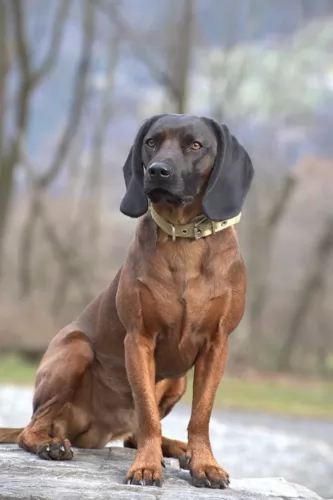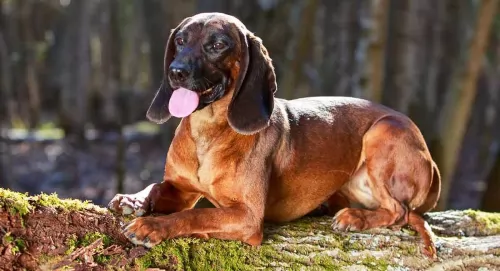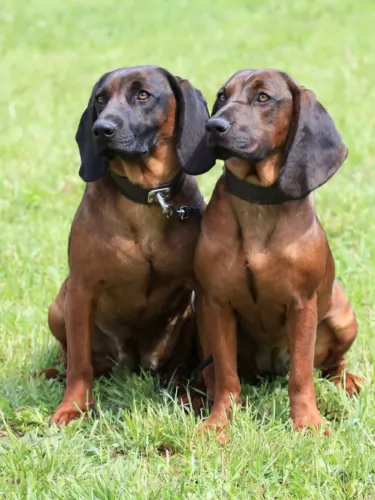 Petzlover
Petzlover Bavarian Mountain Hound is originated from Germany but Scottish Terrier is originated from United Kingdom. Bavarian Mountain Hound may grow 26 cm / 11 inches higher than Scottish Terrier. Bavarian Mountain Hound may weigh 15 kg / 34 pounds more than Scottish Terrier. Both Bavarian Mountain Hound and Scottish Terrier has almost same life span. Both Bavarian Mountain Hound and Scottish Terrier has almost same litter size. Both Bavarian Mountain Hound and Scottish Terrier requires Moderate Maintenance.
Bavarian Mountain Hound is originated from Germany but Scottish Terrier is originated from United Kingdom. Bavarian Mountain Hound may grow 26 cm / 11 inches higher than Scottish Terrier. Bavarian Mountain Hound may weigh 15 kg / 34 pounds more than Scottish Terrier. Both Bavarian Mountain Hound and Scottish Terrier has almost same life span. Both Bavarian Mountain Hound and Scottish Terrier has almost same litter size. Both Bavarian Mountain Hound and Scottish Terrier requires Moderate Maintenance.
 The Bavarian Mountain Hound was originally bred mixing the Bavarian Hound and the Hanover Hound. They decided to mix these breeds in a hope that the new breed will have the best of the parents. Actually, it turned out better than they could even imagine, since they created a great family dog, with magnificent stamina, quiet temperament and supersensitive nose that made them great hunters.
The Bavarian Mountain Hound was originally bred mixing the Bavarian Hound and the Hanover Hound. They decided to mix these breeds in a hope that the new breed will have the best of the parents. Actually, it turned out better than they could even imagine, since they created a great family dog, with magnificent stamina, quiet temperament and supersensitive nose that made them great hunters.
 The Scottish Terrier is also known as the Aberdeen Terrier but people who love and know him refer to him fondly as the Scottie.
The Scottish Terrier is also known as the Aberdeen Terrier but people who love and know him refer to him fondly as the Scottie.
These little dogs were originally bred to hunt vermin on farms and their actual origin is ancient. It is believed that the first descriptions of these dogs date way back to 1436 with there being 2 varieties - a rough-haired Scotch Terrier and a smooth-haired English Terrier.
In 1881 the Scottish Terrier Club of England was founded with the Scottish Terrier Club of Scotland being founded in 1888. Scotties were introduced to America in the early 1890s.
 The Bavarian Mountain Hound is a medium sized breed of a dog. They have larger bones, but there is a very low risk of obesity. This is a very active dog, with a very muscular body. Their bone structure defines in a wide chest, and their back legs set a little bit higher than the front legs. They have strong necks and pear-shaped heads. They have strong jaws, ideal for a hunting dog. They are very specific because of their big brown eyes. The Bavarian Mountain Hound is a perfect pet. First of all, he is not a pack dog. He gets attached to his family and he is not very friendly with strangers. If they are trained well, they will never attack a stranger but they will bark and let you know that something isn’t right.
The Bavarian Mountain Hound is a medium sized breed of a dog. They have larger bones, but there is a very low risk of obesity. This is a very active dog, with a very muscular body. Their bone structure defines in a wide chest, and their back legs set a little bit higher than the front legs. They have strong necks and pear-shaped heads. They have strong jaws, ideal for a hunting dog. They are very specific because of their big brown eyes. The Bavarian Mountain Hound is a perfect pet. First of all, he is not a pack dog. He gets attached to his family and he is not very friendly with strangers. If they are trained well, they will never attack a stranger but they will bark and let you know that something isn’t right.
 The Scottish Terrier is a small dog, fairly robustly built but with short legs. He has a wiry, weather-resistant coat and a soft undercoat. The coat is essentially black but there are other colors too such as a wheaten shade, grey-black and brindle too.
The Scottish Terrier is a small dog, fairly robustly built but with short legs. He has a wiry, weather-resistant coat and a soft undercoat. The coat is essentially black but there are other colors too such as a wheaten shade, grey-black and brindle too.
The ears are erect, the eyes small and bright. The tail isn’t docked but is of medium length and is nearly always held up, without curling over the back.
Height at withers for both males and females should be roughly 23 to 26cm and weight in the region of 8 – 10 kg.
The Scottie is a an independent, robust breed. He is playful as a puppy, but as he matures he becomes more dignified and dour. He is stubborn, but being a terrier he is alert and makes a good watchdog. For a small dog he has a powerful bark.
Brave, loving and loyal, he can fit into life in the city or the countryside so long has he has his human family close by. He doesn’t take kindly to strangers and he he slightly aggressive with other dogs he doesn’t know. He makes a great playmate for children but he certainly doesn’t like being prodded, sat on and poked by small children.
 Special talents: Since the Bavarian Mountain Hound is born with a strong scent, they are great for hunting. They can be trained to be search dogs.
Special talents: Since the Bavarian Mountain Hound is born with a strong scent, they are great for hunting. They can be trained to be search dogs.
If you live slow and quiet life indoors, maybe the Bavarian Mountain Hound is not the best choice for you. They are a calm breed, they do not bark a lot, but they need daily outdoor activity. They usually get attached to the owner, but in case you raise this dog in a family, they will be attached to adults and the children. They are very good while playing and living with the children, but if you usually have a lot of other children or strangers in a house, he will adapt to that kind of social life very easy.
It is very important that you start an early socialization of your Bavarian Mountain Hound. In situations where you raise this breed without the social life, they will have difficulties when they find themselves in situations with other animals. If you raise this breed with other animals in the same home, they will learn to play with other dogs, cats etc.
Bavarian Mountain Hound is not easy to train because they get easy distracted with smelling something more interesting than listening to your commands. It is not advised to have this breed as your first pet because they need an experienced trainer with a lot of patience and understanding.
 The Scottie is strong willed and independent, and training and socialization is important if you don’t want your Scottie believing he has the final say.
The Scottie is strong willed and independent, and training and socialization is important if you don’t want your Scottie believing he has the final say.
These dogs are stubborn and dominant and will need a strong, firm but kind owner. They’re aggressive with other dogs, but get on well with their human family.
When you bring one of these distinctive looking dogs into your home, he’ll be a loving, loyal friend.
 The Bavarian Mountain Hound is a quiet type of the dog. They don’t ask for a lot of attention and even if they develop some health issues you will have a hard time finding it out. So, the regular vet checks are a necessity. They usually suffer from an ear infection. The vet will usually check for a hip or an elbow dysplasia since those diseases occur with highly active breeds. Some irritations with eyelids are also found in the medical history of this breed but they are generally very rare.
The Bavarian Mountain Hound is a quiet type of the dog. They don’t ask for a lot of attention and even if they develop some health issues you will have a hard time finding it out. So, the regular vet checks are a necessity. They usually suffer from an ear infection. The vet will usually check for a hip or an elbow dysplasia since those diseases occur with highly active breeds. Some irritations with eyelids are also found in the medical history of this breed but they are generally very rare.
 Your Scottie is looked upon as being a generally healthy dog breed, but as with any other healthy dogs, he can succumb to some of the conditions and diseases that dogs get -
Your Scottie is looked upon as being a generally healthy dog breed, but as with any other healthy dogs, he can succumb to some of the conditions and diseases that dogs get -
This is an inherited blood disorder where the blood doesn’t clot properly. The dog will bleed excessively after an injury. Fortunately, while there isn’t a cure, dogs can lead normal lives.
Scottish Terriers are more prone to developing cancer than other dogs. Bladder cancer, lymphosarcoma and malignant melanoma are just some of the cancers they can get. Some cancers are treatable and there is a good success rate in dogs receiving chemotherapy.
When you brush your Scottie, look out for new, unusual lumps that could be indicative of cancer.
Scotty Cramp isn’t serious but uncomfortable for your pet. When your dog becomes worked up, you’ll see him arching his spine and he walks around for a few minutes with a stiff unnatural gait.
Obesity is regarded as a serious disease as it puts strain on the dogs joints and also creates back pain and digestive disorders.
 There is a big difference in feeding the Bavarian Mountain Hound since you can raise him to be a pet or a dog for hunting. If you decided to keep this breed as a pet, they will do just fine with one of the dry foods that are good quality. If you want to raise them as a hunting dog, an active dog, then they will need a high-quality dry food and occasionally some raw minced meat.
There is a big difference in feeding the Bavarian Mountain Hound since you can raise him to be a pet or a dog for hunting. If you decided to keep this breed as a pet, they will do just fine with one of the dry foods that are good quality. If you want to raise them as a hunting dog, an active dog, then they will need a high-quality dry food and occasionally some raw minced meat.
High-quality food for puppies with a lot of nutrients that will help in growing the healthy bones and beautiful coat.
Since they have a short coat, the Bavarian Mountain Hounds don’t need a regular or any special kind of grooming. They will do just fine with occasional brushing. They don’t shed a lot, but in a season when they do you are free to brush them more regularly. They enjoy the brushings, cuddles, scratching, belly rubs - they are very lovable breed. But, as advised, take them to regular vet check because they can be very quiet even when they feel the pain.
The Bavarian Mountain Hound has a gene of a working dog and that is the reason why they need a lot of the activity on a daily basis. No matter if you take him to walk, run or a bike ride, they will love it. They do not like being on the leash since they love to use their nose to play. If you socialise them well, the dog park will be a great thing for them.
 Scotties were once bred as working dogs, and they will certainly require daily exercise and stimulation. He will love a walk but you can’t expect him to run with you as he has short legs.
Scotties were once bred as working dogs, and they will certainly require daily exercise and stimulation. He will love a walk but you can’t expect him to run with you as he has short legs.
The Scottie sheds, so he will need to be brushed at least twice weekly. He will require quite a bit of grooming in terms of having the coat professionally trimmed and clipped.
His eyes and ears will need to be checked as well as his teeth. He can’t tell you if he has terrible toothache and while brushing him, check the teeth. Trim his nails too.
It is always recommended that you feed dogs according to size, age and activity levels. Dogs are individuals and they don’t all need the same food.
The quality of the dog food you provide makes a huge difference on your dog’s health. It always pays to go with the better quality kibble available to dogs. Your Scottish Terrier will be depending on your for quality kibble with the right blend of vitamins and minerals.
Dogs thrive on simplicity and consistency and you want to provide him with some home-made food too that gels well with his digestive system. A little bit of raw meat occasionally can also do him the world of good.
Make sure he always has cool, fresh water to drink.